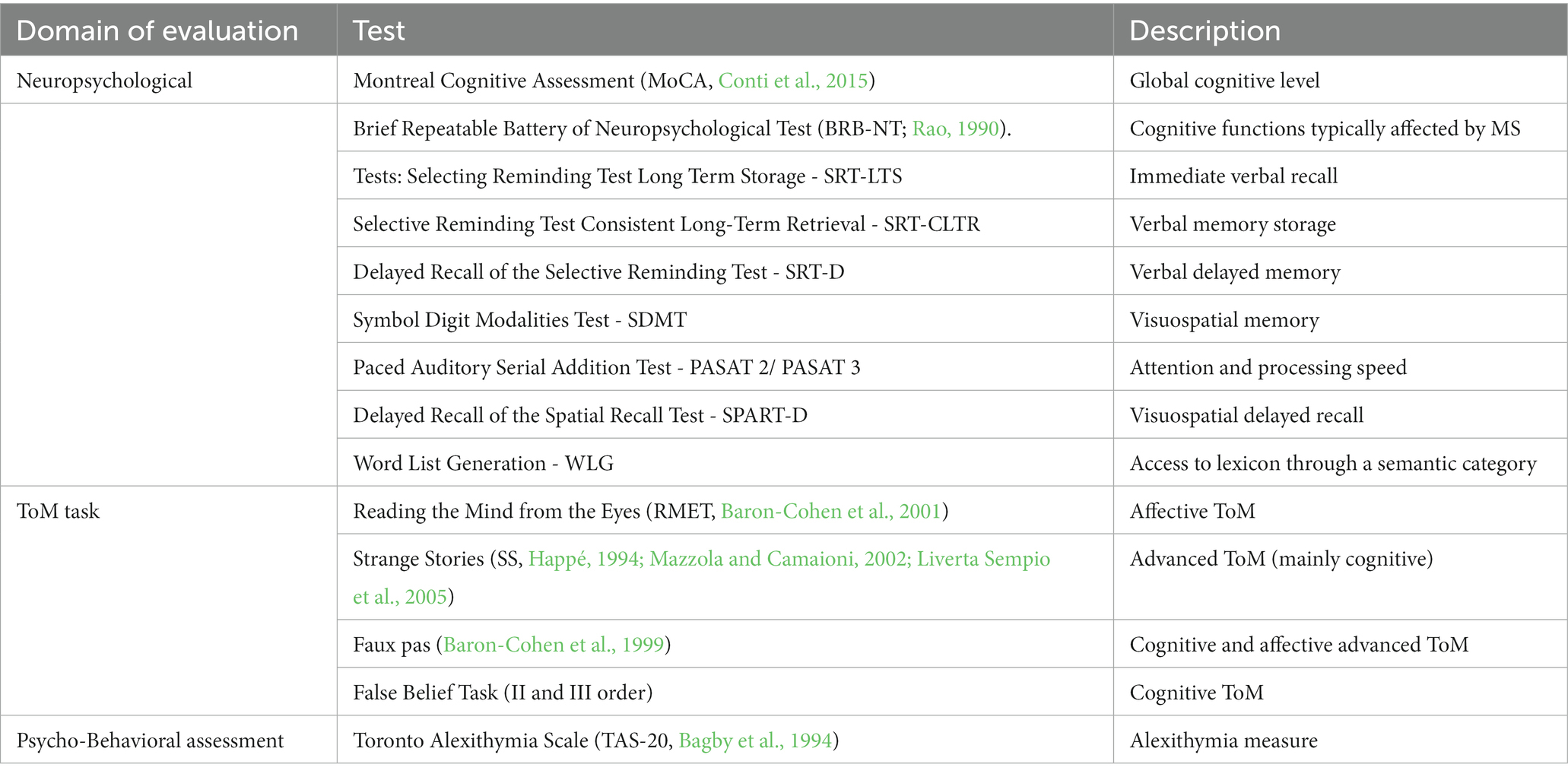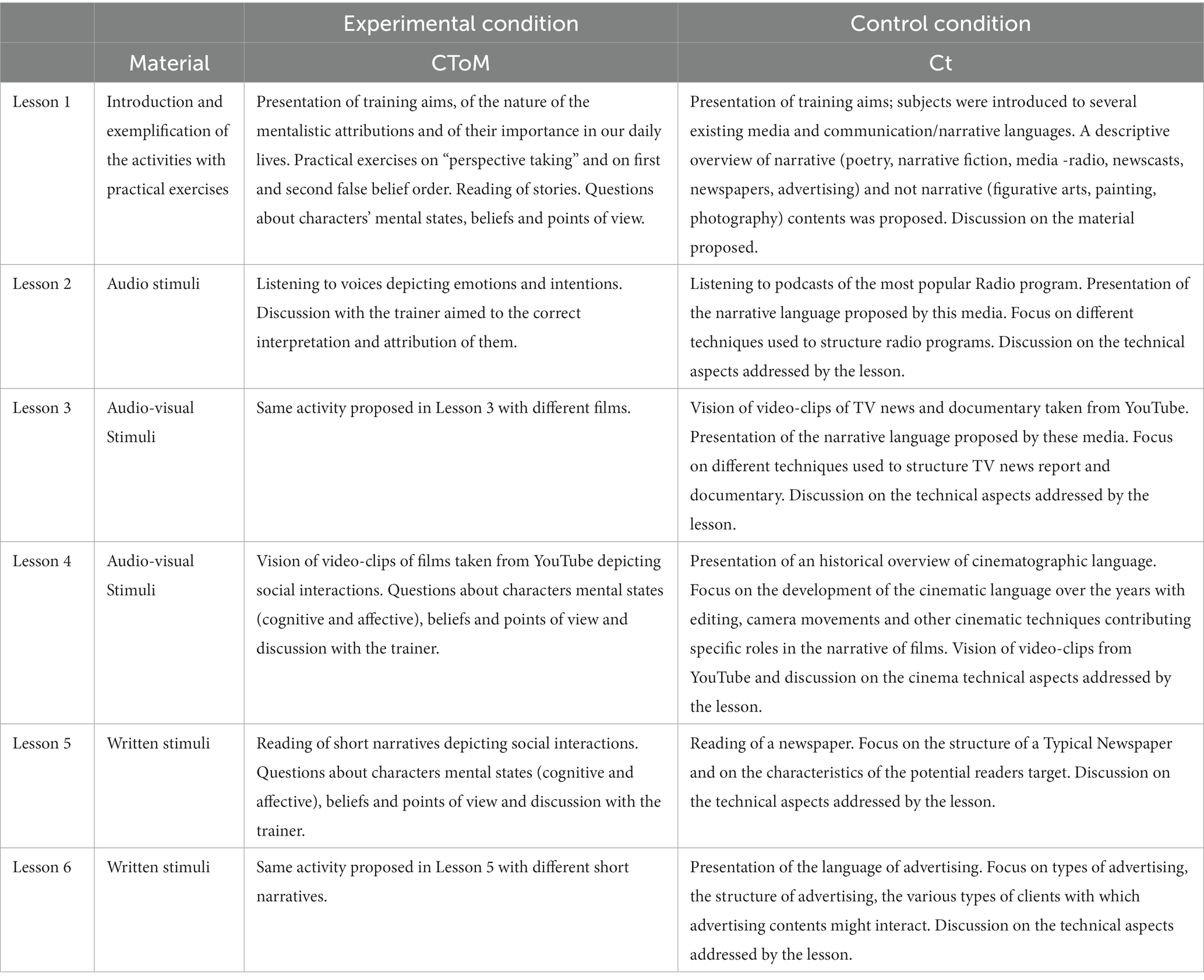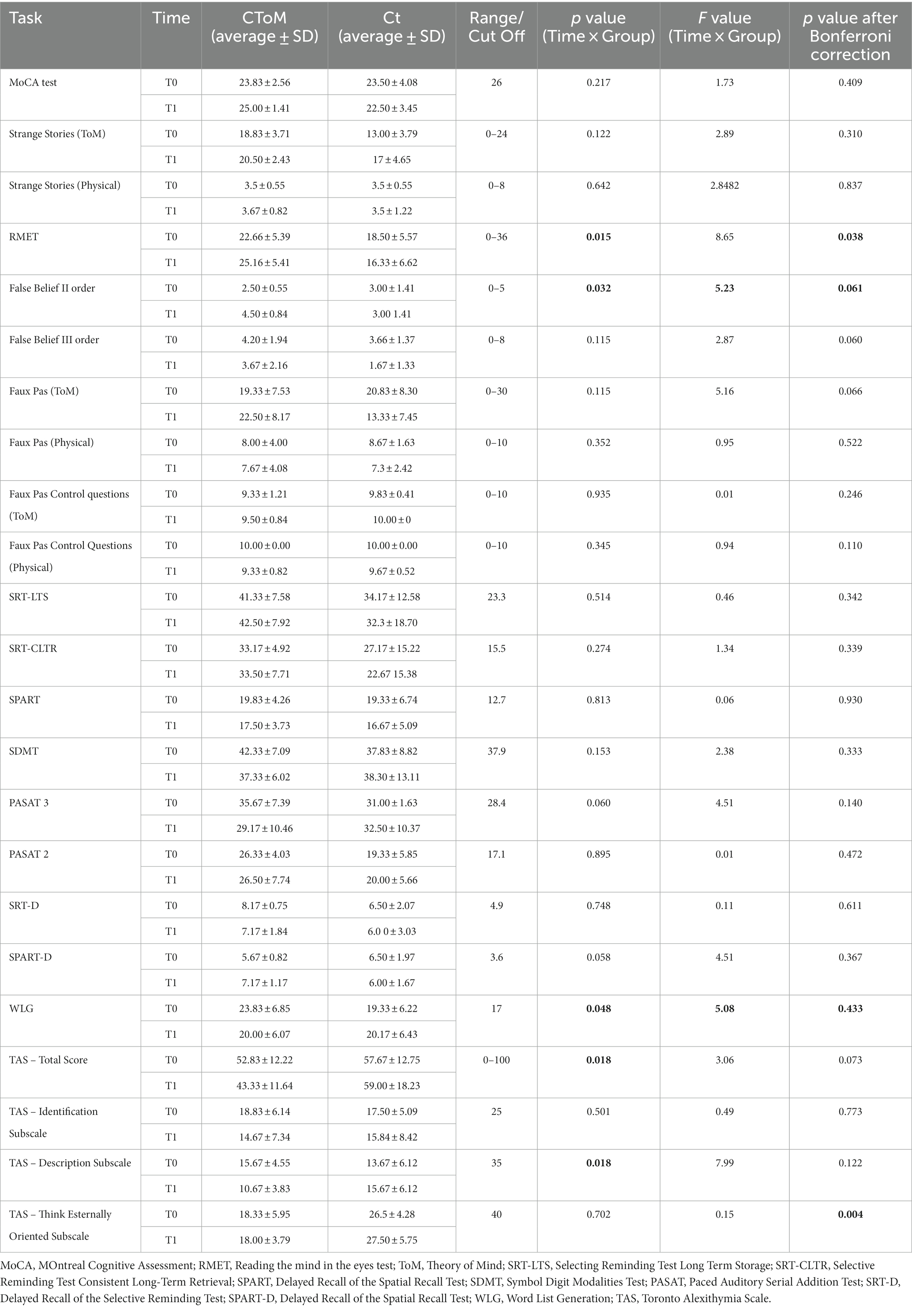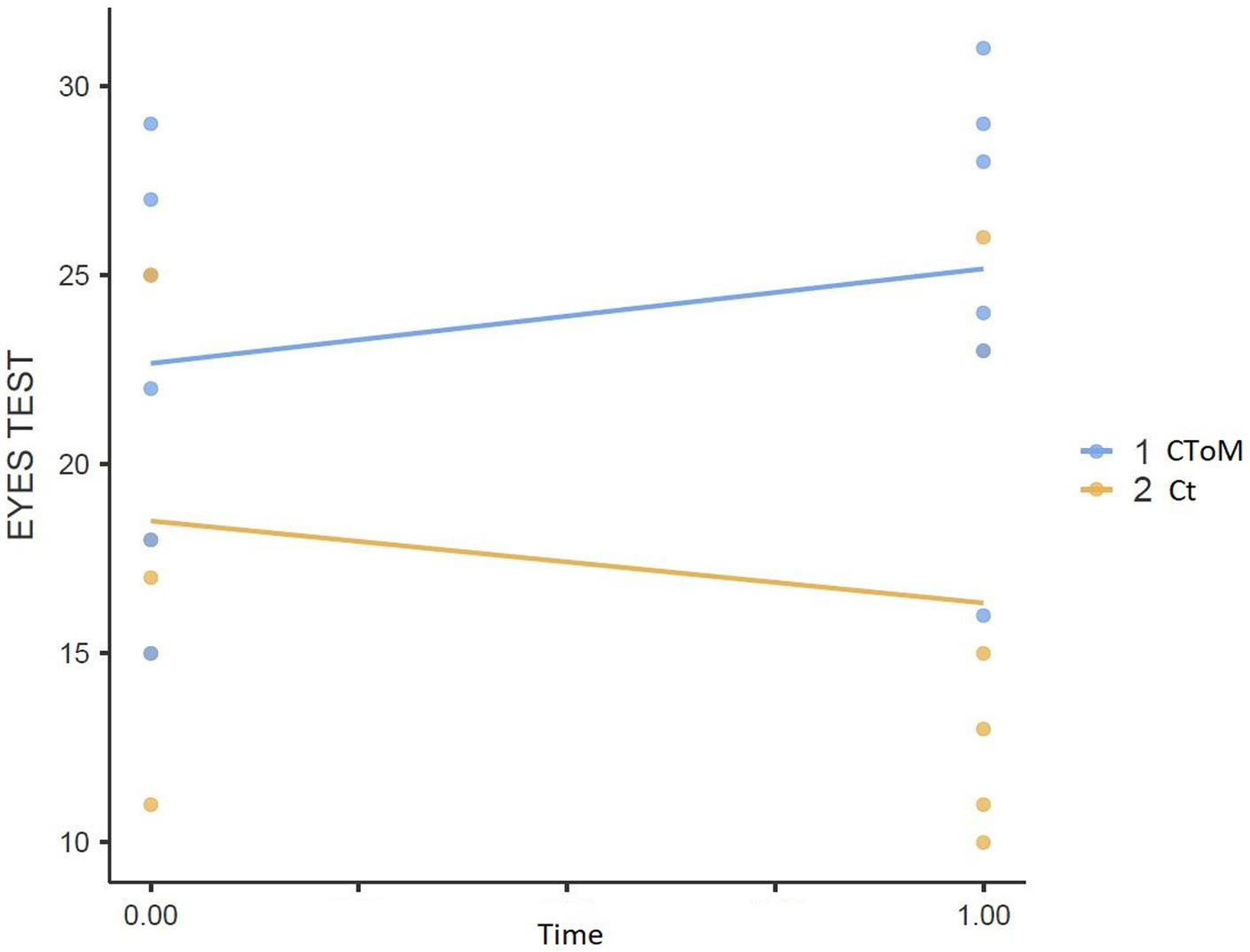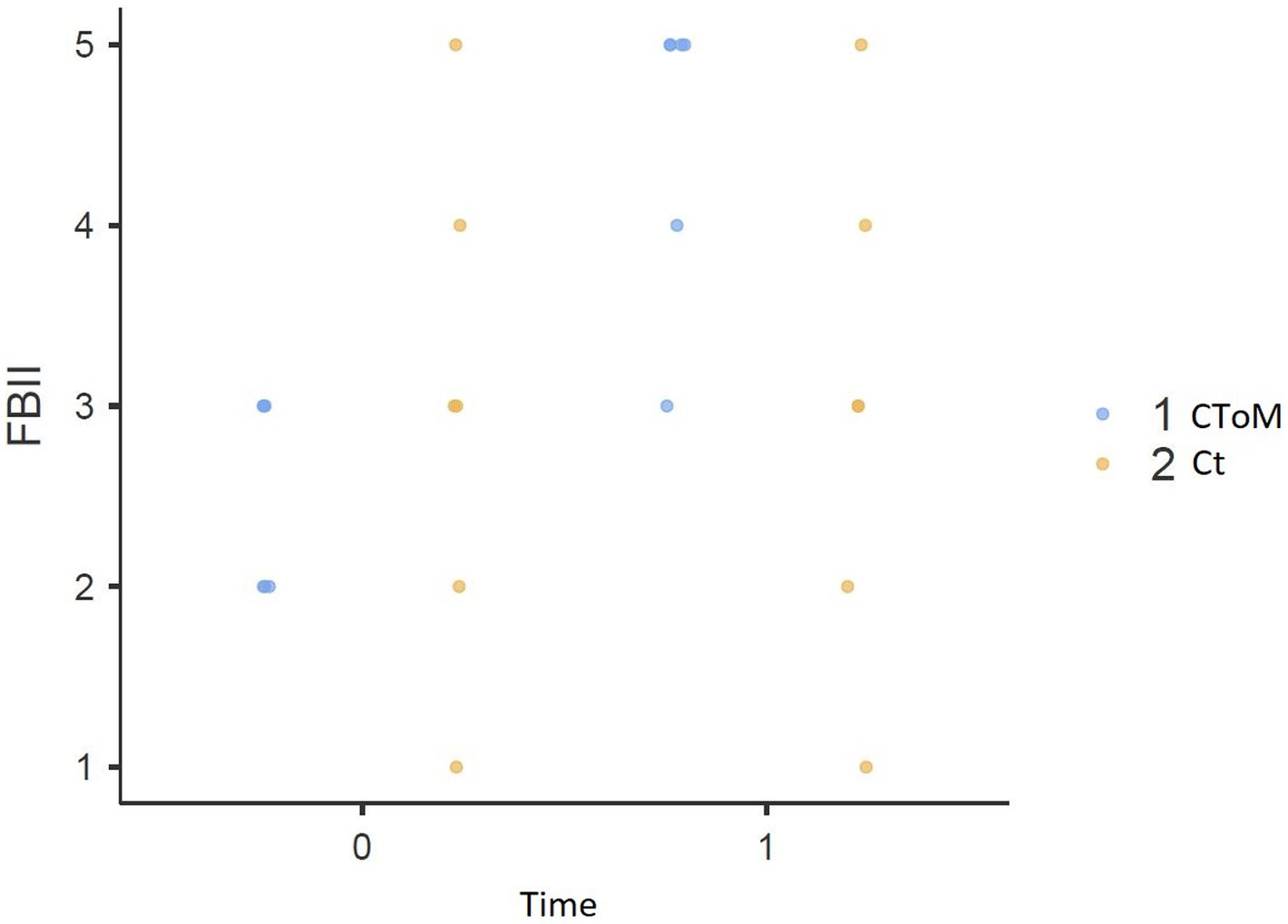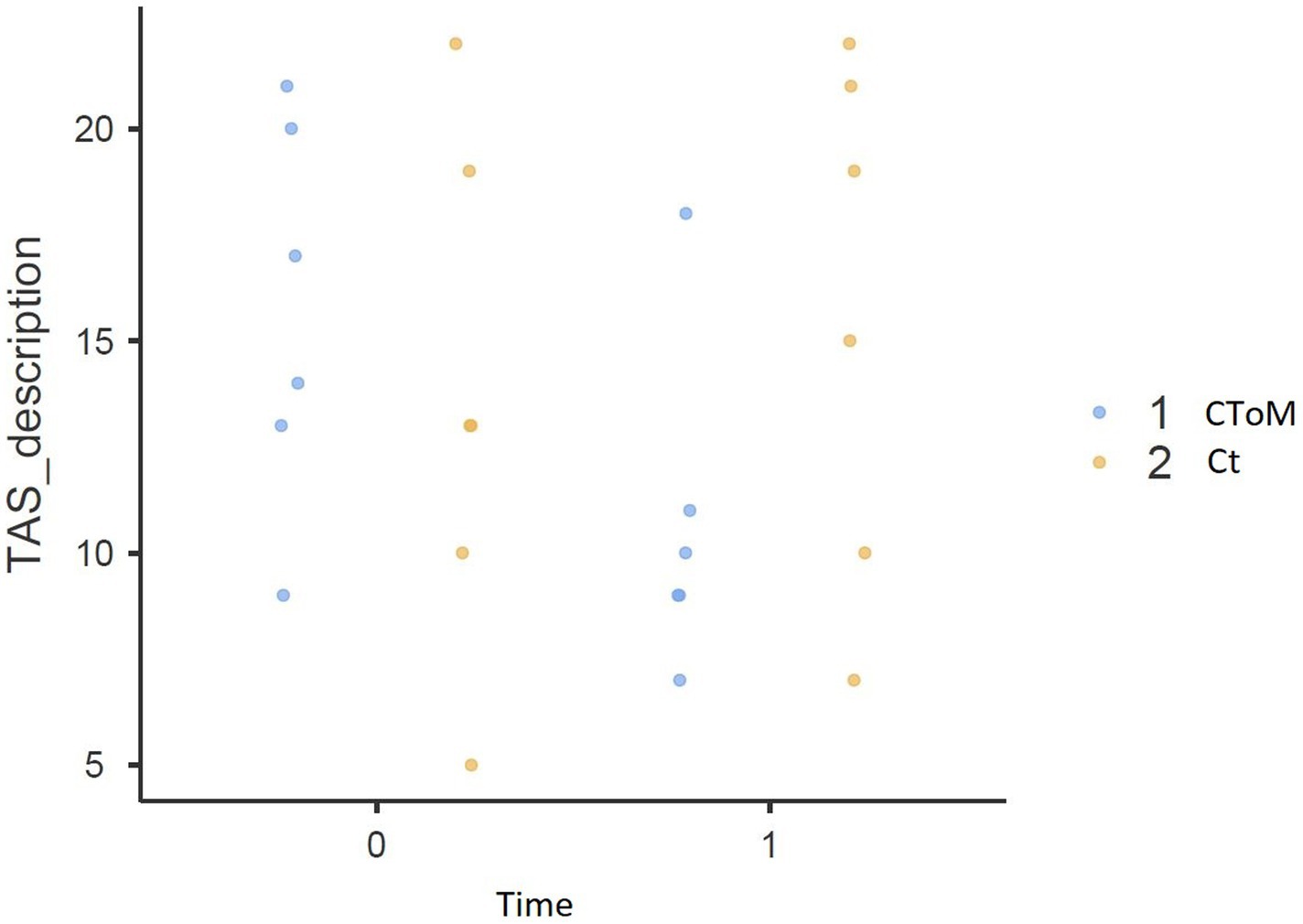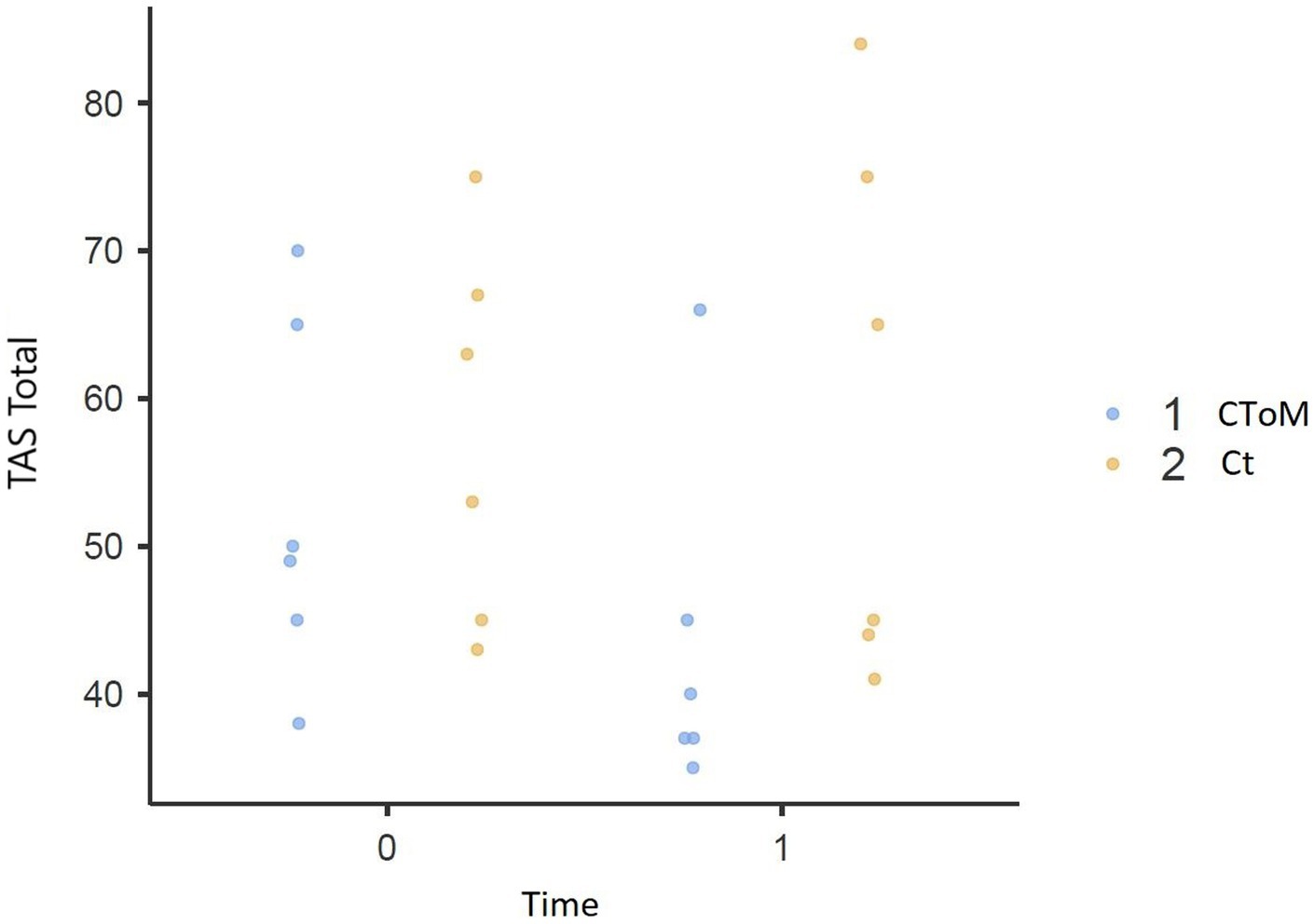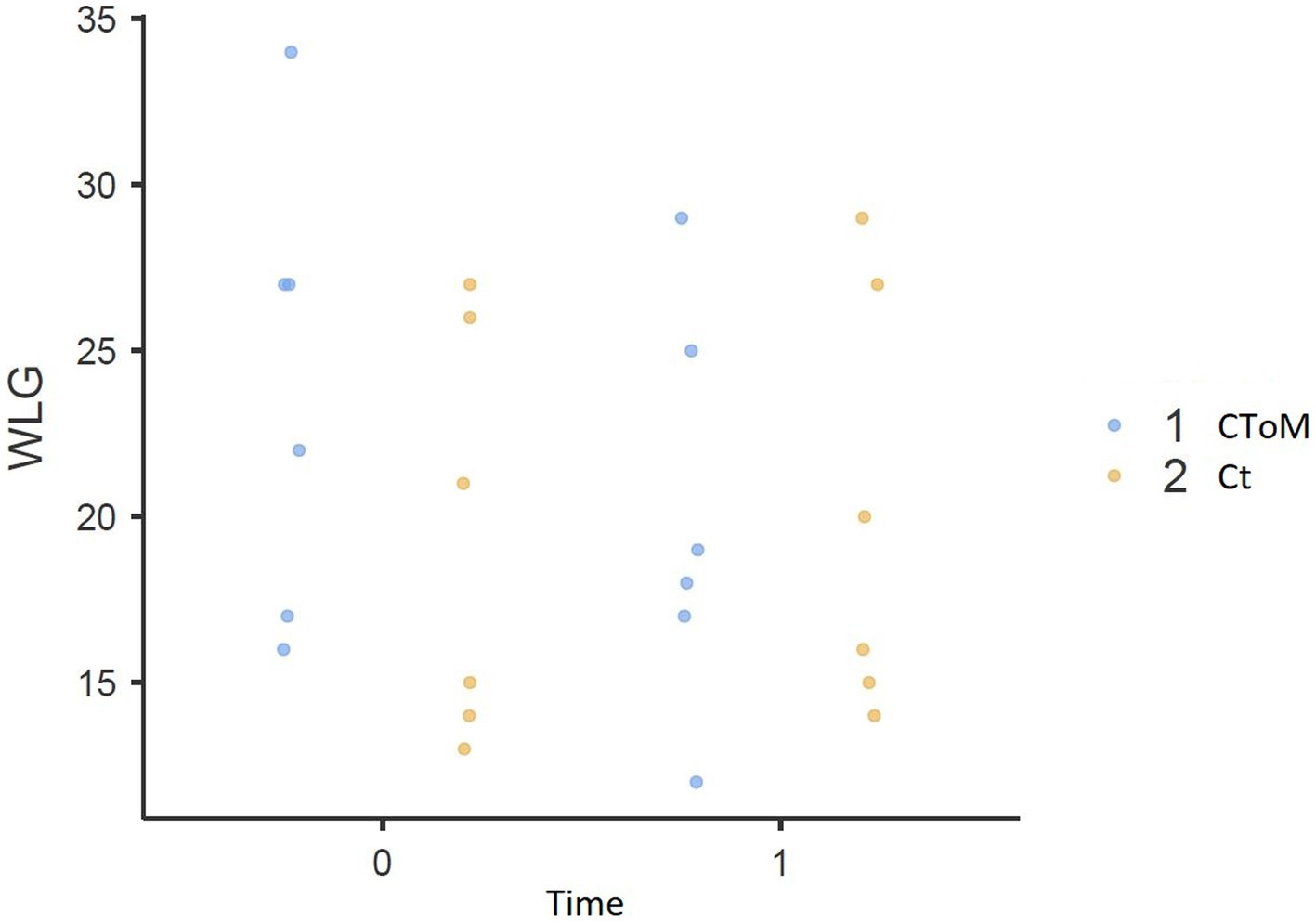- 1Unità di Urologia, Ospedale San Raffaele (IRCCS), Milan, Italy
- 2Unità di Ricerca sulla Teoria della Mente, Dipartimento di Psicologia, Università Cattolica del Sacro Cuore, Milan, Italy
- 3Fondazione Don Carlo Gnocchi Onlus (IRCCS), Milan, Italy
- 4Università Cattolica del Sacro Cuore, Milan, Italy
Theory of Mind (ToM), the ability to understand and attribute mental states to ourselves and others, could be impaired in Multiple Sclerosis (MS), a neurodegenerative disease affecting young adults. Considering that ToM is strictly connected to Quality of Life (QoL) in MS and that could enhance the social support network -which is particularly important for this population-, we aimed to design and implement a novel ToM rehabilitation training. To make the training as much ecological as possible, we have devised a protocol enhancing ToM through stimuli depicting real-world conditions (video-clips taken from cinema movies, literary fictions, and audio voices). We test training’s effect on both cognitive and affective components of ToM in a sample of 13 subjects, randomly assigned to the ToM training Group and to the Control Group. The following ToM tasks were administered: the Reading the Mind in the Eyes (RMET), the Strange Stories task, the Faux Pas Task and the False Belief First- and Second - Order Task (FB II and III order). We also administered a psycho-behavioral assessment through the Toronto Alexithymia Scale (TAS-20). Results show that our novel ToM training is useful in enhancing ToM abilities measured by the following tasks: the RMET (affective task, p = 0.015) and the FB II-order task (FB, cognitive task, p = 0.032). Our ToM training had also a significant effect on the total score of the TAS-20 Scale (p = 0.018) and on its “Difficulty Describing Feelings subscale” (p = 0.018), indicating a reduction of the alexithymia traits. Future works with larger samples could investigate the ToM training effectiveness in a more representative MS populations.
1. Introduction
Successful participation in the social world requires a good comprehension of others’ thoughts, beliefs, and intentions, making accurate inferences about the contents of other people’s minds, and representing them in one’s mind. This complex process is made possible by Theory of Mind (ToM), the ability to understand and attribute mental states to ourselves and others (Premack and Woodruff, 1978), a foundational component of social cognition. ToM is developed throughout our entire life, but some clinical conditions or disturbances could have an impact on the development or maintenance of this ability. Among these, Multiple Sclerosis (MS), a chronic neurodegenerative disorder that impacts both the physical and cognitive status of people affected (pwMS). Recent literature has shown that pwMS show decreased performance in ToM tasks, both in its cognitive and affective domain (Raimo et al., 2017). Isernia et al. (2019) and Roca et al. (2014) suggest that only cognitive ToM is impaired in MS, while Cotter et al. (2016) highlighted a mainly affective ToM deficit in pwMS. Although there is still no agreement on which dimension is more involved, ToM deficit has a relevant impact on the life of pwMS, due to the strong association with reduced social and psychological quality of life (Giazkoulidou et al., 2019). For example, Bora et al. (2016) suppose that relational difficulties identified in pwMS could be related to the ToM deficit (Chiaravalloti and DeLuca, 2008). Considering that social support has an essential role in managing a disease that affects people at a young age (Costa et al., 2017), the treatment of ToM deficits for preserving interpersonal relationships in MS should be relevant in taking charge of this chronic condition. Considering the availability of a wide array of interventions targeted to the empowerment of ToM in other clinical conditions (Kurtz et al., 2016; Ashman et al., 2017; Edel et al., 2017; d’Arma et al., 2020) and in normal aging (featured by a decrease of ToM; Cavallini et al., 2015; Rosi et al., 2016), no training is currently established for the pwMS. For this reason, the present study aimed to design and preliminarily test the efficacy of a novel cultural ToM training (CToM; d’Arma et al., 2021) to promote emotional and cognitive mental state understanding in pwMS.
2. Materials and method
2.1. Participants
We conducted a RCT pilot study (Clinical Trial ID: NCT04711941, record nr: 5_25/07/2019); the randomization was computer-based type. A sample of 13 subjects with MS was consecutively recruited from the Neuromotor Rehabilitation Unit of Don Carlo Gnocchi Foundation, IRCCS in Milan [Italy; 6 participants were included in the experimental condition –ToM training – and 7 participants were included in the control condition (Non Mentalistic training)].
Inclusion criteria were: (1) diagnosis of Relapsing–Remitting (RR), Secondary Progressive (SP) and Primary Progressive (PP) MS based on the revised MC Donald criteria (Thompson et al., 2018), (2) age ≥ 18 and ≤75 years, (3) years of education ≥5, (4) stable pharmacological treatment in the 6 months before the enrollment, (5) no clinical relapses or use of steroid treatment during 3 months before the enrollment, (6) provided informed consent for study participation.
Exclusion criteria were: (1) history of nervous system disorders different from MS, (2) absence of unstable psychiatric illness, such as psychosis or major depression, (3) severe disability based on an Expanded Disability Status Scale (EDSS) score > 7.5, (4) severe cognitive impairment that would not enable pwMS to answer to questionnaires correctly (i.e., dementia), according to the patient’s medical records.
The study was conducted in compliance with the Helsinki Declaration of 1975, as revised in 2008. Local Ethics Committee (Don Carlo Gnocchi Foundation) approved the study, and written informed consent to be included in the study was obtained from participants before study initiation.
2.2. Neuropsychological, ToM, and psycho-behavioural assessment
Participants were randomly assigned to one of the two groups: the ToM training (experimental condition) and a non-mentalistic training (control condition).
Subjects belonging to both groups were individually assessed at the baseline (T0) and after 4 weeks at the end of the training (T1) regarding a neuropsychological evaluation, a ToM evaluation, and a psycho-behavioral evaluation. Blind neuropsychologists carried out the evaluation session. It was divided into two sessions, lasting about 1 h each.
Participants underwent a conventional neuropsychological, ToM and psycho-behavioral assessment as detailed in the Table 1 below.
Demographical data were also collected by a neurologist: clinical onset, disease duration, EDSS score.
2.3. Procedures
After the baseline assessment, subjects were randomly assigned with the block randomization method to the experimental condition or to the control condition, each consisting of six 45-60 min lessons twice a week (for a total of 3 weeks). Training was set up during the ward-rehabilitation period of each PwMS. A psychologist conducted the training program in both conditions. The design of the two trainings was oriented by an ecological approach (Bechi et al., 2012, 2013; Cavallini et al., 2015), using stimuli derived from cinema and literature, since there is strong evidence that they could greatly impact ToM abilities (Mar et al., 2006, 2009; Fong et al., 2013; Kidd and Castano, 2013; Tabullo et al., 2018).
The Control training (Ct) activities were matched with those of the CToM for the modalities of delivery and type of material (number of lessons, length, visual stimuli, audio stimuli, and written stimuli). In the control condition, discussions in the lessons concerned physical and non-mentalistic states.
A full description of the training materials is provided in Table 2.
2.3.1. Cultural theory of mind training
For the design of the CToM presented in this study, we have considered existing literature: for the modalities (number of sessions, length, type of stimuli, etc.), we took into consideration the results of our previous systematic review and meta-analysis (d’Arma et al., 2020) and other ToM interventions already implemented in other clinical and not clinical population (Bechi et al., 2012, 2013, 2015; Cavallini et al., 2015; Lecce et al., 2015; Rosi et al., 2016). To respond to the need for an “ecological” treatment, we chose to use video, and audio stimuli depicting social interactions from cinema movies and TV fiction, as already implemented in Bechi et al. (2012, 2015). We proposed different activities (reading of stories, listening to audio voices, seeing a video-tape depicting human social interactions) to work on ToM capacity from different perspectives. The consideration of different skills that could contribute to cognitive or affective ToM could maximize the training’s impact on this ability. To make the training even more engaging, we also chose to use readings from fiction and literature. This idea is supported by a strand of work of Kidd and Castano (2013), Mar et al. (2006, 2009), Fong et al. (2013), and Tabullo et al. (2018), which have explored how literary fiction could enhance social abilities as empathy and ToM. This choice is supported by the results of an acceptability study confirming that CToM had been judged as very acceptable by pwMS (d’Arma et al., 2021).
During each training session, through several types of stimuli, the psychologist worked together with the participant to comprehend and hypothesize interpretations of the emotions and social interactions referred to the stimulus proposed (for example, scenes from movies or short stories), providing occasions in which participants were actively involved in the discussion in order to enhance the attribution of mental states and emotions. All materials proposed included exercises by which participants could answer to questions about thoughts and feelings of the characters; feedbacks from the psychologist conductor have served to raise the discussion about ToM contents.
2.3.2. Control training
To compare our experimental condition with an active control group, we designed a parallel intervention not focused on ToM. According to the results emerging from our previous acceptability study (d’Arma et al., 2021), in which most pwMS reported making frequent use of communications media like newspapers, Tv and Radio, etc., we decided to design a pathway to deepen the different ways of communication, analyzing several types of existing communication. We provided a historical and descriptive overview of cinema movies, TV news, documentaries, newspapers, and advertising in every lesson. Particular attention was paid to the avoidance of mental states and emotional reasoning during the presentation of the stimuli and the subsequent discussion. The proposal’s objective was to avoid enhancing the ToM, mindreading competencies, and executive functions. As in the experimental condition, participants were actively involved in the discussion: All materials proposed included exercises by which participants could answer to questions about descriptive features of the contents proposed. The aim of this condition was to maintain the same format of the experimental condition with the clause of not taking in consideration any issues relating to thoughts and feelings (to avoid the bias of indirectly ehanching ToM).
2.4. Statistical analysis
The analyses were performed with SPSS 24.0. and with Jamovi statistical software (The Jamovi Project 2020, version 1.2).
For the description of the sample’s demographic characteristics, descriptive analyses were performed, including means, standard deviation (SD), and range for continuous variables as appropriate.
To test if and how our CToM could impact ToM abilities, a statistical comparison between experimental subjects and control participants was performed.
Before evaluating the effect of the training, we compared at the baseline the two groups to assess if they were comparable through the ANOVA one way method. For the demographic variables, we confirmed the normal distribution with the Shapiro–Wilk normality test.
To analyze the CToM effect, we conducted an analysis of the variance with a mixed model with a random effect. The analysis was performed through a linear mixed model fit by REML algorithm. As Fixed Effect parameters we put time, group, age, and education. As random components, subjects and residual are set. Convergence is present in all the tests performed with mixed model.
3. Results
Table 3 reports the principal demographic characteristics of the participants and the group’s comparison. One subject was considered a drop out because of its exit from the study (the subject had to discontinue its hospitalization for the first Italian lockdown on March 2020).
The two groups did not differ significantly for any of the demographic variables considered; hence they are comparable. The age, the education, and the disease duration were normally distributed, except for the EDSS score.
In Table 4 results of the analysis of the variance were shown.
We found a statistically significant Time × Group effect on the RMET test (p = 0.015), on the False Belief II order task (p = 0.032), on the WLG test (p = 0.048), in the total score of the TAS-20 (p = 0.018) and the Description Subscale of the TAS-20 (p = 0.018) (Figures 1–5).
4. Discussion
These results of our study show that our novel CToM training could be useful in the enhancement of ToM, in both affective and cognitive components. Regarding the affective ToM, the analysis showed a highly significant effect of the training on the RMET; the use of cultural stimuli improves ToM and particularly the affective component, as shown in the work of Kidd and Castano (2013). Specifically, our CToM training enhances the emotion recognition of the characters of the cultural stimuli presented (deriving from cinema and literature), contextualizing them in the several conditions displayed. We can assume that fictions (read or seen) propose narratives and frame significant for the subjects (Bruner and Bruner, 1990), motivating them to apply their ToM ability. To understand the stimuli of the CToM training, mainly important is to correctly attribute the emotions to the characters; this training is composed by situations in which the protagonists experience different emotions in the face of the same event and, as in real-life, the adequate interpretation of emotional states guide the understanding of the situation itself.
Regarding the cognitive ToM, our CToM training has also shown a significant effect on the second-order false-belief task, but not on the third-order reasoning. This is probably since that higher ToM reasoning is difficult to do even for non-clinical people (see, for example, Valle et al., 2015), then it is probably inaccessible in a clinical situation characterized by a ToM deficit. Instead, the second-order ToM, usually reached around 8 years of age (Perner and Wimmer, 1985), can be more sensitive to the CToM, that proposes multiple situations regarding, for example, gaffes or non-direct communications, requiring second-order recursive reasoning to be understood. Nevertheless, the CToM training does not seem to generalize its impact on the advanced ToM tasks, the Strange Stories, and the Faux pas test, for which we found a trend toward significance. This is probably due to the complexity of the advanced ToM tasks, that requires very high competences in the social context, that pwMS could not reach due to the MS disease. Furthermore, a very small number of the subjects have been included in this study: in the future, a sample’s enlargement could show a more evident impact on ToM abilities.
These results support the idea that a generic training rehabilitation, such as the Ct here proposed, is not enough to enhance the specific ability of ToM in a sample of clinical population: on the contrary, it seems that is precisely the work on the comprehension of emotions and mental states together with the enhancement of mental states inferences to be effective in enhancing basic ToM abilities (as happen also in other type of population, i.e., primary school children; Bianco et al., 2021). This result is corroborated by the fact that there was no statistically significant improvement in both groups in the neuropsychological evaluation.
Only in the WLG task, assessing verbal fluency, the control condition shows a higher performance at T1 respect to the T0. This effect could be due to the nature of the control condition: indeed, even though we pose particular attention to avoid the focus on mentalistic ability in the non-mentalistic training, the six control condition lessons were characterized by lengthy discussions on the different types of communication currently available. Although non-mentalistic training seems to be not effective on ToM domain and other executive functions, it is possible that the fluency could be enhanced by the discussion held in the control condition.
Our CToM also had a significant effect on the alexithymia, reduced in the experimental group, indicating an improvement of the alexithymia traits after the CToM. Alexithymia was a relevant issue in patients with MS (Eboni et al., 2018), and it was associated with increased severity of fatigue and depression (Bodini et al., 2008). The result obtained in the “Difficulty Describing Feelings subscale” of the TAS-20 in favor of the experimental group confirms that conversations and discussions about mental states and emotions in an ecological manner could help pwMS describe feelings and emotions. Because one of the problems in managing MS is the improvement of the patient-physician interaction (Alroughani, 2015), this result confirms the importance to set ToM trainings in order to translate the results from the research setting to clinical practice, overcoming the gap between research discoveries and routine practice of treatments (Rothwell, 2005).
There are several limits to be considered for the interpretation of these results. The Covid-19 pandemic emergency negatively impacted the recruitment of the subjects: subjects were recruited during their rehabilitation hospitalization in the Rehabilitation Unit of the Multiple Sclerosis Center of the Don Gnocchi Foundation that, for several months, were stopped to give priority to another kind of hospitalization most appropriate at that stage. So, at that moment we have been able to recruit only 13 subjects, of which one has been considered a drop out just due to anti-COVID 19 strategic measures (the subject had to discontinue its hospitalization for the first Italian lockdown on March 2020). To date, the rehabilitation unit is still open and resumed MS rehabilitation hospitalization, however not without some inevitable changes. Operators must wear several personal safety protection devices that could impact the relationship between the training and the inpatients even if they do not interfere with the training itself. Related to this limit, we have to pinpoint that we are aware of the limit in fitting a linear mixed model despite the small number of our populations; this is only a pilot study and we had the need to understand the effect of our ToM training controlling contents and methods of the treatment, in order to give an indication of differences among times × groups.
Furthermore, pwMS recruited from our Rehabilitation Unit is often in a stage of disease with moderate and severe disability, making it difficult to generalize these preliminary results to the MS population, which presents a greater degree of variability.
5. Conclusion
Our study provides preliminary findings on the efficacy of our CToM training for rehabilitating and enhancing the ToM abilities in pwMS. The effect is detectable not only on ToM tasks (both affective and cognitive), but also on alexithymia traits. Due to the crucial repercussions that they have on social interactions, social support networks, and QoL, the possibility to implement rehabilitation training for the empowerment of ToM ability in this population should be considered in clinical settings. However future studies are needed for verifying the effectiveness of four rehabilitation methods in samples with larger size and more representative of the MS population of patients.
Data availability statement
The original contributions presented in the study are included in the article/supplementary material, further inquiries can be directed to the corresponding author.
Ethics statement
The studies involving human participants were reviewed and approved by Comitato Etico - Fondazione Don Carlo Gnocchi. The patients/participants provided their written informed consent to participate in this study.
Author contributions
AV, FB, DM, and AM conceived and planned research and contributed to the management, the coordination of the research activity, the supervision of the evolution of the research goals and of the revision of the manuscript. Ad'A conceived and planned research, collected data and contributed to the data entry, to statistical analysis, to the synthesis and the presentation of study data, drafting and submitting the manuscript. GB contributed to data collection and data entry. SI contributed to data collection and revision of the manuscript. MR managed and cohordinated the patient recruitment and contributed to the revision of the manuscript. Ad'A and AV wrote the first draft of the manuscript. SDT that perform statistical analysis, revised the manuscript and contribute to the final form of the manuscript. All authors contributed to the article and approved the submitted version.
Funding
This work was funded by the Italian Ministry of Health (“Ricerca Corrente” - 2022-2024 Program).
Conflict of interest
The authors declare that the research was conducted in the absence of any commercial or financial relationships that could be construed as a potential conflict of interest.
Publisher’s note
All claims expressed in this article are solely those of the authors and do not necessarily represent those of their affiliated organizations, or those of the publisher, the editors and the reviewers. Any product that may be evaluated in this article, or claim that may be made by its manufacturer, is not guaranteed or endorsed by the publisher.
References
Alroughani, R. A. (2015). Improving communication with multiple sclerosis patients. Neurosciences 20, 95–97. doi: 10.17712/nsj.2015.2.20140441
Ashman, R., Banks, K., Philip, R. C., Walley, R., and Stanfield, A. C. (2017). A pilot randomised controlled trial of a group based social skills intervention for adults with autism spectrum disorder. Res. Autism Spectr. Disord. 43, 67–75. doi: 10.1016/j.rasd.2017.08.001
Bagby, R. M., Parker, J. D., and Taylor, G. J. (1994). The twenty-item Toronto alexithymia scale—I. item selection and cross-validation of the factor structure. J. Psychosom. Res. 38, 23–32. doi: 10.1016/0022-3999(94)90005-1
Baron-Cohen, S., O’Riordan, M., Jones, R., Stone, V., and Plaisted, K. (1999). A new test of social sensitivity: detection of faux pas in normal children and children with Asperger syndrome. J. Autism Dev. Disord. 29, 407–418. doi: 10.1023/A:1023035012436
Baron-Cohen, S., Wheelwright, S., Hill, J., Raste, Y., and Plumb, I. (2001). The “Reading the mind in the eyes” test revised version: a study with normal adults, and adults with Asperger syndrome or high-functioning autism. J. Child Psychol. Psychiatry Allied Discip. 42, 241–251. doi: 10.1111/1469-7610.00715
Bechi, M., Bosia, M., Spangaro, M., Buonocore, M., Cocchi, F., Pigoni, A., et al. (2015). Combined social cognitive and neurocognitive rehabilitation strategies in schizophrenia: neuropsychological and psychopathological influences on theory of mind improvement. Psychol. Med. 45, 3147–3157. doi: 10.1017/S0033291715001129
Bechi, M., Riccaboni, R., Ali, S., Fresi, F., Buonocore, M., Bosia, M., et al. (2012). Theory of mind and emotion processing training for patients with schizophrenia: preliminary findings. Psychiatry Res. 198, 371–377. doi: 10.1016/j.psychres.2012.02.004
Bechi, M., Spangaro, M., Bosia, M., Zanoletti, A., Fresi, F., Buonocore, M., et al. (2013). Theory of mind intervention for outpatients with schizophrenia. Neuropsychol. Rehabil. 23, 383–400. doi: 10.1080/09602011.2012.762751
Bianco, F., Lombardi, E., Lecce, S., Marchetti, A., Massaro, D., Valle, A., et al. (2021). Supporting Children’s second-order recursive thinking and advanced ToM abilities: a training study. J. Cogn. Dev. 22, 561–584. doi: 10.1080/15248372.2021.1901712
Bodini, B., Mandarelli, G., Tomassini, V., Tarsitani, L., Pestalozza, I., Gasperini, C., et al. (2008). Alexithymia in multiple sclerosis: relationship with fatigue and depression. Acta Neurol. Scand. 118, 18–23. doi: 10.1111/j.1600-0404.2007.00969.x
Bora, E., Özakbaş, S., Velakoulis, D., and Walterfang, M. (2016). Social cognition in multiple sclerosis: a meta-analysis. Neuropsychol. Rev. 26, 160–172. doi: 10.1007/s11065-016-9320-6
Bruner, J., and Bruner, J. S. (1990). Acts of meaning: Four lectures on mind and culture, vol. 3, Harvard University Press.
Cavallini, E., Bianco, F., Bottiroli, S., Rosi, A., Vecchi, T., and Lecce, S. (2015). Training for generalization in theory of mind: a study with older adults. Front. Psychol. 6:1123. doi: 10.3389/fpsyg.2015.01123
Chiaravalloti, N. D., and DeLuca, J. (2008). Cognitive impairment in multiple sclerosis. Lancet Neurol. 7, 1139–1151. doi: 10.1016/S1474-4422(08)70259-X
Conti, S., Bonazzi, S., Laiacona, M., Masina, M., and Coralli, M. V. (2015). Montreal cognitive assessment (MoCA)-Italian version: regression based norms and equivalent scores. Neurol. Sci. 36, 209–214. doi: 10.1007/s10072-014-1921-3
Costa, D. C., Sá, M. J., and Calheiros, J. M. (2017). Social support network and quality of life in multiple sclerosis patients. Arq. Neuropsiquiatr. 75, 267–271. doi: 10.1590/0004-282x20170036
Cotter, J., Firth, J., Enzinger, C., Kontopantelis, E., Yung, A. R., Elliott, R., et al. (2016). Social cognition in multiple sclerosis: a systematic review and meta-analysis. Neurology 87, 1727–1736. doi: 10.1212/WNL.0000000000003236
d’Arma, A., Isernia, S., Di Tella, S., Rovaris, M., Valle, A., Baglio, F., et al. (2020). Social cognition training for enhancing affective and cognitive theory of mind in schizophrenia: a systematic review and a Meta-analysis. J. Psychol. 155, 26–58. doi: 10.1080/00223980.2020.1818671
d’Arma, A., Valle, A., Di Tella, S., Massaro, D., Rovaris, M., Baglio, F., et al. (2021). A theory of mind training for people with multiple sclerosis: development of a scale to assess the treatment acceptability. Curr. Psychol. 42, 1–11. doi: 10.1007/s12144-021-02457-1
Eboni, A. C. B., Cardoso, M., Dias, F. M., Gama, P. D. D., Gomes, S., Goncalves, M. V. M., et al. (2018). High levels of alexithymia in patients with multiple sclerosis. Dement. Neuropsychol. 12, 212–215. doi: 10.1590/1980-57642018dn12-020015
Edel, M. A., Raaff, V., Dimaggio, G., Buchheim, A., and Brüne, M. (2017). Exploring the effectiveness of combined mentalization-based group therapy and dialectical behaviour therapy for inpatients with borderline personality disorder–a pilot study. Br. J. Clin. Psychol. 56, 1–15. doi: 10.1111/bjc.12123
Fong, K., Mullin, J. B., and Mar, R. A. (2013). What you read matters: the role of fiction genre in predicting interpersonal sensitivity. Psychol. Aesthet. Creat. Arts 7, 370–376. doi: 10.1037/a0034084
Giazkoulidou, A., Messinis, L., and Nasios, G. (2019). Cognitive functions and social cognition in multiple sclerosis: an overview. Hell. J. Nucl. Med. 22
Happé, F. G. (1994). An advanced test of theory of mind: understanding of story characters' thoughts and feelings by able autistic, mentally handicapped, and normal children and adults. J. Autism Dev. Disord. 24, 129–154. doi: 10.1007/BF02172093
Isernia, S., Baglio, F., d’Arma, A., Groppo, E., Marchetti, A., and Massaro, D. (2019). Social mind and long-lasting disease: focus on affective and cognitive theory of mind in multiple sclerosis. Front. Psychol. 10:218. doi: 10.3389/fpsyg.2019.00218
Kidd, D. C., and Castano, E. (2013). Reading literary fiction improves theory of mind. Science 342, 377–380. doi: 10.1126/science.1239918
Kurtz, M. M., Gagen, E., Rocha, N. B., Machado, S., and Penn, D. L. (2016). Comprehensive treatments for social cognitive deficits in schizophrenia: a critical review and effect-size analysis of controlled studies. Clin. Psychol. Rev. 43, 80–89. doi: 10.1016/j.cpr.2015.09.003
Lecce, S., Bottiroli, S., Bianco, F., Rosi, A., and Cavallini, E. (2015). Training older adults on theory of mind (ToM): transfer on metamemory. Arch. Gerontol. Geriatr. 60, 217–226. doi: 10.1016/j.archger.2014.10.001
Liverta Sempio, O., Marchetti, A., and Castelli, I. (2005). Traduzione Italiana Delle Strane Storie E Delle Storie Fisiche. Unità di Ricerca sulla Teoria della Mente, Dipartimento di Psicologia, Università Cattolica del Sacro Cuore, Milano.
Mar, R. A., Oatley, K., Hirsh, J., Dela Paz, J., and Peterson, J. B. (2006). Bookworms versus nerds: exposure to fiction versus non-fiction, divergent associations with social ability, and the simulation of fictional social worlds. J. Res. Pers. 40, 694–712. doi: 10.1016/j.jrp.2005.08.002
Mar, R. A., Oatley, K., and Peterson, J. B. (2009). Exploring the link between reading fiction and empathy: ruling out individual differences and examining outcomes. Communications 34, 407–428. doi: 10.1515/COMM.2009.025
Mazzola, V., and Camaioni, L. (2002). Strane Storie: Versione Italiana A Cura Di Mazzola E Camaioni. Dipartimento di Psicologia dinamica e clinica, Università “La Sapienza”, Roma.
Perner, J., and Wimmer, H. (1985). "John thinks that Mary thinks that…": attribution of second-order beliefs by 5- to 10-year-old children. J. Exp. Child Psychol. 39, 437–471. doi: 10.1016/0022-0965(85)90051-7
Premack, D., and Woodruff, G. (1978). Does the chimpanzee have a theory of mind? Behav. Brain Sci. 1, 515–526. doi: 10.1017/S0140525X00076512
Raimo, S., Trojano, L., Pappacena, S., Alaia, R., Spitaleri, D., Grossi, D., et al. (2017). Neuropsychological correlates of theory of mind deficits in patients with multiple sclerosis. Neuropsychology 31:811. doi: 10.1037/neu0000372
Rao, S. M. (1990). Cognitive function study group, Nmss: A manual for the brief repeatable battery of neuropsychological tests in multiple sclerosis. New York, NY: National Multiple Sclerosis Society.
Roca, M., Manes, F., Gleichgerrcht, E., Ibáñez, A., De Toledo, M. E. G., Marenco, V., et al. (2014). Cognitive but not affective theory of mind deficits in mild relapsing-remitting multiple sclerosis. Cogn. Behav. Neurol. 27, 25–30. doi: 10.1097/WNN.0000000000000017
Rosi, A., Cavallini, E., Bottiroli, S., Bianco, F., and Lecce, S. (2016). Promoting theory of mind in older adults: does age play a role? Aging Ment. Health 20, 22–28. doi: 10.1080/13607863.2015.1049118
Rothwell, P. M. (2005). External validity of randomised controlled trials:“to whom do the results of this trial apply?”. Lancet 365, 82–93. doi: 10.1016/S0140-6736(04)17670-8
Santangelo, G., Siciliano, M., Pedone, R., Vitale, C., Falco, F., Bisogno, R., et al. (2015). Normative data for the Montreal cognitive assessment in an Italian population sample. Neurol. Sci. 36, 585–591. doi: 10.1007/s10072-014-1995-y
Tabullo, A. J., Jiménez, V. A. N., and García, C. S. (2018). Associations between fiction Reading, trait empathy and theory of mind ability. Int. J. Psychol. Psychol. Ther. 18, 357–370.
Thompson, A. J., Banwell, B. L., Barkhof, F., Carroll, W. M., Coetzee, T., Comi, G., et al. (2018). Diagnosis of multiple sclerosis: 2017 revisions of the McDonald criteria. The Lancet Neurology. 17, 162–173.
Keywords: Multiple Sclerosis, rehabilitation, rehabilitation training, ToM, social cognition
Citation: d’Arma A, Valle A, Massaro D, Baglio G, Isernia S, Di Tella S, Rovaris M, Baglio F and Marchetti A (2023) A cultural training for the improvement of cognitive and affective Theory of Mind in people with Multiple Sclerosis: a pilot randomized controlled study. Front. Psychol. 14:1198018. doi: 10.3389/fpsyg.2023.1198018
Edited by:
Alfonsina D’Iorio, University of Campania Luigi Vanvitelli, ItalyReviewed by:
Giorgio Arcara, San Camillo IRCCS S.r.l. Società Unipersonale, ItalyBenito Pereira Damasceno, State University of Campinas, Brazil
Copyright © 2023 d’Arma, Valle, Massaro, Baglio, Isernia, Di Tella, Rovaris, Baglio and Marchetti. This is an open-access article distributed under the terms of the Creative Commons Attribution License (CC BY). The use, distribution or reproduction in other forums is permitted, provided the original author(s) and the copyright owner(s) are credited and that the original publication in this journal is cited, in accordance with accepted academic practice. No use, distribution or reproduction is permitted which does not comply with these terms.
*Correspondence: Francesca Baglio, ZmJhZ2xpb0Bkb25nbm9jY2hpLml0
 Alessia d’Arma
Alessia d’Arma Annalisa Valle
Annalisa Valle Davide Massaro
Davide Massaro Gisella Baglio2
Gisella Baglio2 Sara Isernia
Sara Isernia Marco Rovaris
Marco Rovaris Francesca Baglio
Francesca Baglio Antonella Marchetti
Antonella Marchetti